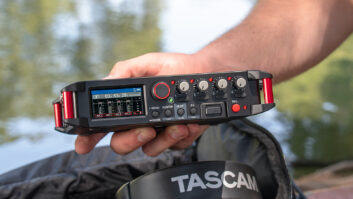
There are, among us, many reporters, field recordists and crazy stunt interns who still today refuse to part with their favorite field acquisition recorder, be it a classic Marantz cassette unit, a handheld Sony MiniDisc machine or a well-worn Denon DAT deck.
Whether due to sentimentality, familiarity or just the sting of how much a new unit costs, lots of these old workhorses plod along yet today.
But modern portable solid-state digital recorders have it completely over those previous-generation machines. Full binaural recording, mechanical shock immunity and precise built-in microphones (with the resultant absence of XLR cables) are some of the advantages of modern memory card recorders.
Of course, the primary benefit of these devices is instant offload into a DAW via USB for editing or immediate ingest into the station’s audio library.
While those cassette-slingin’ cowpokes of yesteryear have to spool their cuts off in real time — and hope the tape doesn’t jam or stretch — broadcasters who use devices such as the TASCAM DR-100 Portable Digital Recorder are already off to the next story.
Feature set
Early versions of flash RAM recorders — such as the futuristic metallic Nagra/Digigram ARES recorder of a decade ago — got the ball rolling. Today, many manufacturers boast memory card recorders, all of which sound superb; these days, it is hard to find a pro digital audio device that sounds bad.
The difference is the feature set. For example, TASCAM didn’t stop at one microphone combination for the DR-100 but gives us the choice of three. And with the addition of phantom power, a built-in limiter and extensive control over all audio settings, there is something here for every broadcaster tasked with bringing it back alive from the field. It also has heft that gives it a serious feel, as opposed to the plasticky, almost fragile feel of devices such as the Zoom H2.

So let’s begin with the mics. Many portable recorders today are festooned with pairs of stereo electret elements mounted to the tops of the units. Some in a snug X-Y cross pattern, some spread wide like an ORTF pair.
The primary mic array on the DR-100 is arranged much like the latter. The two metal capsules, while appearing as a parallel spaced pair, actually conceal cardioid elements that tip a total of 90 degrees outward from each other. You can use this recorder to capture a handheld or tabletop “two-voicer” with superb isolation and not have to pass a mono mic back and forth between the two of you.
While not hypercardioid, the stereo image can be unusually wide. This is noticeable if a recording of a musical ensemble is made with such a recorder. With huge width could come mono compatibility issues when the tracks collapse. So the DR-100 also boasts a pair of omni stereo elements on the front face of the unit for such times. Aiming the mics at the sound source becomes a little less critical. More room tone and background walla might be picked up, but sometimes you just need to take it all in.
Unlike lots of other recorders on the market now, the DR-100 has a pair of phantom-powered XLR mic inputs on the bottom of the device. You are thus not restricted to the microphones that are bolted to the recorder and are free to use your favorites, dynamic or condenser. All three are controlled handily and quickly from a front-panel slide switch and not lost beneath menu layers.
Speaking of bolting, the back of the DR-100 has a threaded socket sized for a common photo tripod, so the recorder can be mounted and pointed in the direction of your sound source. I have found that in broadcast as well as music, mic stands are more prevalent than tripods, and companies such as On Stage Stands make inexpensive mic-to-tripod adapters. It might be worth TASCAM’s while to consider including such an adapter as part of the package.

On the reverse panel, slide switches to engage a limiter, phantom power and mic sensitivity add to the versatility of the multi-mic option. And a flush-mount stereo input control on the right side of the recorder rounds everything out.
Thanks for the memory, I guess
The DR-100 absolutely requires an SD/SDHC memory card to record. There does not appear to be any internal RAM. The unit I checked out came with a 2 GB card which clicks into a slot along the top between the cardioid capsules.
If 2 GB sounds fairly small these days, consider that setting the record rate to 32 kbps/MP3 provides just shy of 24 hours of continuous recording time (the DR-100 defaults to 16-bit/44.1 kHz WAV on startup). But at this setting we are straining the edge of compromise between fidelity and recording time. Bigger cards, up to 32 GB high-capacity SDHC, work just fine in the DR-100.
In its default mode, the DR-100 records at 44.1 kHz or 48 kHz sample rate. If you were hoping for higher-definition recording, prepare for a delightful surprise: holding down the Enter button while powering up puts the recorder in HS mode, and moves you up to 24-bit and 96 kHz. There is a tradeoff of course. That 2 GB card fills up in only an hour.
Buttons and controls for the DR-100 are not “under the thumb,” nor are they expected to be anymore. “Texting” on mobile phones these days has unexpectedly taught us a novel skill, and holding and working the front-panel controls with both thumbs is natural and effortless, especially since we aren’t holding a mic in that other hand anymore.
Clicking the Home key on the recorder switches the display between elapsed time and remaining time, if you’re the kind of user who needs to see your media running low before taking action.
The PB Control switches in a pitch and speed changer, allowing you to swing through a range of –50 to +16 percent of original speed and pitch. Handy if you need to fly quickly through a cut to find the payoff sound bite.
In-unit editing capabilities are limited to dividing files. If you have experience with MiniDiscs, you well know you can delete sections and perform basic splicing. On the DR-100, you are able to drop markers during recording to highlight and locate the magic moment in a recording — just hit that big Enter/Mark button in the middle of the jog wheel.
Product Capsule TASCAM DR-100 Portable Digital Recorder
Thumbs Up
- + Solid serious feel, not flimsy
- + Two separate mic arrays + external mic inputs
- + Decent recording time
Thumbs Down
- – No editing software included.
Price
$599
For information, contact TASCAM in California at (323) 726-0303 or visit www.tascam.com. Remember again, this device is meant for recording and for moving files into a computer for editing, so going all-out with an editing toolkit would be somewhat superfluous.
As for that computer editing, use the USB connector to offload your files. It’s fast and it works. Opening the SD card slot and repeatedly removing and replacing the card will wear out that part of the recorder prematurely. Files are named either by date (yymmdd-0123) or by a six-letter name of your choosing (newsFM-0123).
Finally, there are line-in and line-out plugs for connecting the recorder to the analog world; and the choice of powering the DR-100 with AA cells, a drop-in lithium-ion battery, or a 5V DC power supply — regrettably not included.
Decisions
It’s a tough call when choosing among portable digital recorders. To my eye, the closest threat to the TASCAM DR-100 is the Sony PCM M10, which boasts a five-second record buffer and a copy of the Sony-owned “Sound Forge” editing software.
But the Sony has only omni microphones, and if you want to use external mics, you would be plugging into a 1/8-inch jack, which does not inspire confidence in the heat of battle.
We all have our favorite digital editor, and we could always obtain a copy of Audacity off the Web if need be, but frankly I wished TASCAM offered up some kind of editing software for the DR-100 so you can go to work right out of the box. If not for that, and the absence of built-in resident RAM, I would call it a clean sweep on this review.
So if you have an active news staff — or a crazy stunt intern trolling the promo nights for happy listeners to scream call letters — do it in style and bring it back fast with a TASCAM DR-100.
Alan Peterson, CBT, CEA is the assistant chief engineer for the Radio America Network in Arlington, Va. He can be reached at[email protected].







